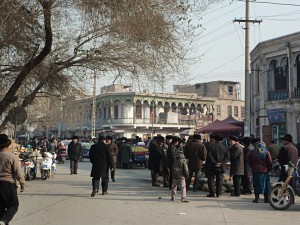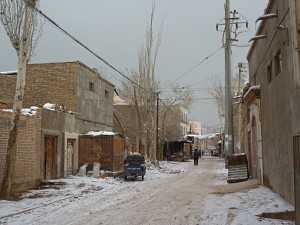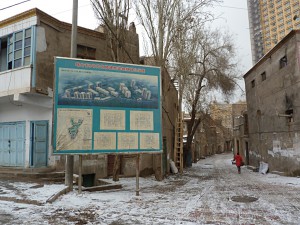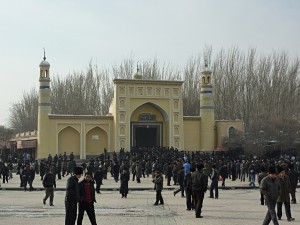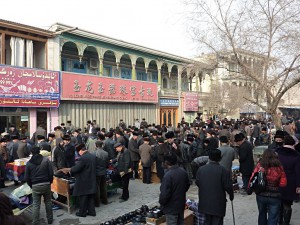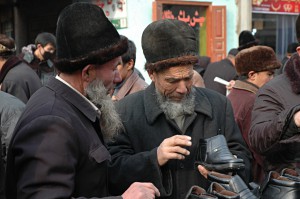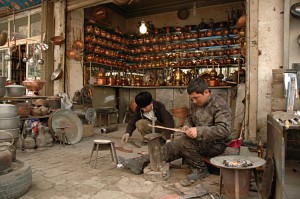After the countries of Central Asia I crossed the last border of my trip entering a new culture. But the culture of the Uyghurs is not all that different from the Central Asian countries. But in Kashgar as anywhere in Xinjiang there live not only Uyghurs but in the meantime many Han-Chinese people.
Kashgar in the far West of China was a very important trading center on the silk road. The trading routes from the South, from India and Pakistan, from the West, from Central Asia, and from the East, from the Chinese silk road met here. Today this is still very present as there are many travelers who explore those ancient ways stopping for some time in Kashgar.
After quite a few days of traveling on my own I finally met other travelers in Kashgar, who were one more or less similar ways as I. With a Russian couple and an American we exchange how we had all crossed the Irkeshtam pass and figured that the Chinese only had changed the immigration procedure a few days before I entered the country. Every one had their litte stories to tell, but the most fasyinating were those of Ruben from France who arrived from Afghanistan via Tadjikistan and Kyrgyzstan. It was very interesting to hear from someone first hand who had been to that shaken country. After hearing his stories I still would not dare to enter the country then I consider too large the uncertainties and risks. Apparently it is very difficult to obtain reliable information on the transport and security situation throughout the country.
We used the evenings in the Kashgar Old Town Youth Hostel to exchange experiences and plans. For me it is always interesting to see how differently people travel. The Russian couple, Dasha and Slava, for example was traveling on the bare minimum. This means that their preferred means to get from one place to another is hitchhiking. In Russia and Central Asia this apparently worked out fine for them also due to the fact that Russian is spoken at least by a part of the population in those countries. The challenges to hitchhike in China however are quite a bit larger such that they decided to cross a good part of the country by a hard seat train namely from Kashgar to Lanzhou.
I used to the two days to figure out what my next destinations on the silk road would be, to organize some cash and especially to get to know the intricate details of the split city of Kashgar. The originally Uyghur city is being changed in a Chinese city bit by bit. The statement that the old town is being bulldozed as such does not seem real, but one can recognize how changes are taking place, because there are single buildings here and there which either collapsed or were destroyed and are being replaced by modern Chinese buildings and outside of the old town of whole building complexes.
By walking the streets of the old town and in the surrounding parts one can still find a lot of traditional Uyghur life. Besides the largest mosque in China, the Id Kah mosque in the center of Kashgar, there are also small mosques in many side streets which are also extensively visited. One of the more impressive events I was able to observe was the end of the Friday prayer in the Id Kah mosque. Thousands of traditionally clothed Uyghurs with their praying carpets under their arms left the mosque to immerse themselves into the streets where dealers were selling all kinds of products and expecting the dominantly male crowd.
Besides the typical products especially the food stalls and the restaurants wre flooded. In the Night Market opposite the mosque all seats were taken rapidly. The Kebab barbequers were endlessly putting their liver, lamb- and beef-meat on their barbqueus, where they kept their fire hot and burning, to feed the hungry crowd.
During the Friday prayer I considered that it was not worth it to take out my SLR camera, since there were not going to be many people in the streets. But once the crowd left the mosque I hurried back to the Youth Hostel to pick up the camera to equip myself better. My goal was to catch as many of the characteristic faces who were evaluating the goods and negotiating the price. The people were deeply immersed in their actions such that they did not notice when I almost stuck my lens in their face. I still tried to leave them a little privacy not to distrurb them too much.
On Saturday I first set out on my own to explore some streets outside the old town. In those streets I realized that the buildings were all built next to each other with a tall wall facing the street. A large gate in the wall gives into a large courtyard which is surrounded by a patio. This was exactly the same pattern I had seen in the historical houses in Kashan in Iran and other places in the desert in Iran. I assume that this kind of architecture also had been made known by people traveling the silk road.
In the afternoon Ruben joined me for some more exploration, this time we were looking for the Sunday Market, which still spotted a few buyers even on Saturday. Ruben was looking for a new hat even though he had bought a very nice one in Tadjikistan. Several dealers noted his interest, which was not large enough to actually buy something. In the market we decided to head into one of the food stalls to drink a tea to warm up a little. The owner immediately showed interest in Ruben’s hat, which Ruben offered to him for 10US$. That was asking too much of the fellow, even though Ruben apparently had paid 25US$ for it.
I laso used the time in Kashgar to determine my further destinations in Xinjian. A center-piece of my planning was the bus ride through the Takla Makan desert. This would lead me from Hotan on the Southern Silk Road to some place on the Norhern Silk Road. Since I had arrived in Kashgar a few days earlier than expected I could visit some more places on the way so I decided to stop in Yarkand for the Sunday Market there before moving on to Hotan.
On Sunday morning I headed to the bus station early. My walk was accompanied by quite a bit of snow fall, which had all the streets and sidewalk covered in white. Unfortunately the first bus for Yarkand only left at 11am Bejing time such that I had to wait for more than an hour for the bus. My plan of being in Yarkand as early as possible crumbled some more when the bus was having diffulties getting through the snow and traffic in Kashgar. In this case I should have inquired better and chosen the train, which left a few minutes before the train and was much faster…

